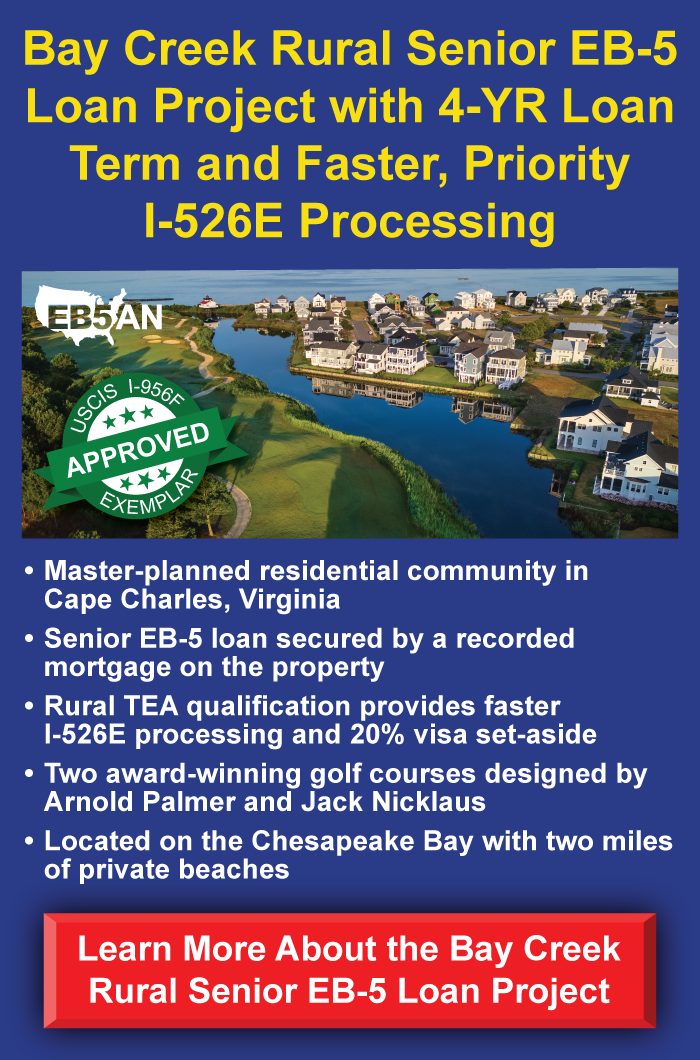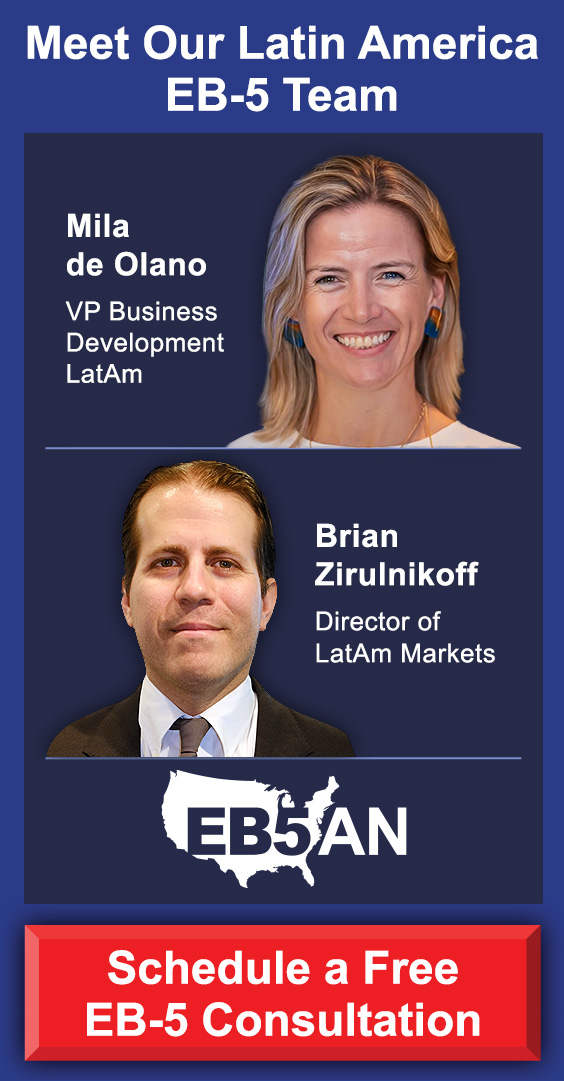For decades, the EB-5 Immigrant Investor Program has offered foreign nationals a pathway to U.S. lawful permanent resident status in exchange for investing in a U.S. business.
No EB-5 project is completely free of risk. However, EB5AN minimizes risk by choosing robust projects from reliable developers. We identify projects that need below-market investment capital but do not depend entirely on EB-5 funds to be successful.
In this article, we’ll explain the strict criteria we use to ensure our clients get access to the best EB-5 real estate investment opportunities.
Why EB5AN Chooses Real Estate Projects for Its Investors
How EB5AN Chooses Real Estate Projects
- We Choose Projects With Robust Capital Stacks
- We Partner With Developers That Have Strong Track Records
- We Prioritize Targeted Employment Areas
- We Know Which Properties Sell
- We Seek to Protect EB-5 Investments
- We Choose Developers With Strong Project Plans and Financial Projections
Case Study: Twin Lakes Georgia
Other EB5AN Projects
Invest in Low-Risk, High-Quality Developments With EB5AN
Why EB5AN Chooses Real Estate Projects for Its Investors
Real estate stands out as the best option for EB-5 investments.
These are some of the reasons why.
A Fast, Flexible Path to a Green Card
Real estate projects tend to have short timelines, unlike mining or energy projects that sometimes require decades of work before development can start. With real estate, construction can begin quickly, and progress is visible for all involved parties to see.
Regional center-sponsored real estate projects also have flexible job creation criteria, and may count direct, indirect, and induced jobs toward the job creation requirement.
Stable, Reliable Returns on Investment
Real estate usually provides reliable and predictable returns on investment. Demand for housing has risen steadily. Lenders often prefer to finance real estate investments. It’s easier to estimate costs, sales values, and time frames with real estate than with some other investment choices.
Inflation poses little risk to EB-5 real estate investors because the value of the real estate market tends to outstrip inflation. Real estate investments have a track record of being a good inflation hedge against losses in the U.S. dollar.
Direct Path to Repayment
Real estate projects can repay investors through sales or property refinancing, instead of depending on profits as manufacturing industries do.
How EB5AN Chooses Real Estate Projects
When we evaluate a real estate project, we always consider the developer’s reliability and the likelihood of construction meeting EB-5 program requirements.
Here are our main considerations in choosing real estate projects.
We Choose Projects With Robust Capital Stacks
EB5AN provides mezzanine funding with extensive senior loans in place and clear repayment plans. Our typical project reflects a diverse funding structure.
Here’s an example of how we ensured a robust capital stack for the 428-home development project (now closed) in Wohali, Utah:
1. Funding Breakdown
- Senior loans, developer equity, and home-sales revenue formed the majority of capital.
- EB-5 funding was intentionally kept small in the capital stack—the development did not rely exclusively on EB-5 funds to proceed, reducing risk for investors.
2. Investor Structure & Repayment Terms
- Each investor’s EB-5 contribution was handled via individual loan tranches, each with its own five-year term.
- The first investor in was the first out—the repayment order aligned with individual tranche timing, not dependent on minimum investor count or USCIS approvals.
3. Security Features
- Loans were secured by mortgages on thousands of acres of land.
- There was a 100% equity pledge from the development entity, offering robust security for investor capital even in the event of visa denials.
We Partner With Developers That Have Strong Track Records
A strong developer should have a 25+ year track record of successful project completion, building billions of dollars of real estate in the same asset class. They should have completed every project they started, with a minimum of 10 EB-5 projects completed and a 100% USCIS project approval rate.
The developers we work with have never failed to complete a project or repay loans. Our developers have “skin in the game”—they are co-investing with their own funds.
While there is no exact minimum required, aiming for a 10-30% co-investment ensures that the project is sufficiently backed by the developer, provides confidence to EB-5 investors, and aligns with industry best practices. The more the developer invests, the greater the likelihood of attracting investors and the higher the perceived stability of the project.
We at EB5AN have experience delivering EB-5 projects and following through on meeting job creation requirements for our clients. We have never had an EB-5 project rejected by USCIS.
We choose developers who are transparent and happy to share financial statements on a regular basis.
We have no history of lawsuits, bankruptcies, or fraud allegations. If you encounter a developer with a history of any of these, it’s crucial to perform comprehensive due diligence. Evaluate the developer’s current standing, past legal issues, and the transparency of their project. Consult with legal and immigration experts, and consider alternative projects if there are substantial risks.
Your investment and immigration future depend on selecting a safe and reputable project, so don’t rush into any decision without assessing these critical factors.
We Prioritize Targeted Employment Areas
We use USCIS-approved regional centers for the Targeted Employment Area (TEA) projects we endorse, and secure faster processing times with lower investment amounts for our clients.
For EB-5 regional centers and developers, prioritizing TEA projects offers a host of strategic advantages, from lowering the investment threshold for investors to gaining access to financial incentives and public support. It not only helps fulfill the EB-5 program’s job creation and economic development goals, but also positions the developer for long-term growth, making these projects an attractive choice for both investors and stakeholders.
By taking such steps, we reduce immigration risk and financial risk for EB-5 investors.
We Know Which Properties Sell
Each EB-5 project’s target demographic is a large, growing population segment that is wealthy enough to buy the properties.
At EB5AN, we fund properties that are proven to appeal to the targeted demographic, such as single-family homes for rural investments. We also offer projects located near major urban areas, where demand is high from a large population of buyers.
For example, EB5AN’s Twin Lakes, Georgia project targets affluent retirees—a large, growing, and wealthy demographic—near Atlanta. The project caters to those who are 55 years of age or older, with the financial capacity to make substantial down payments.
We Seek to Protect EB-5 Investments
EB5AN takes the security of EB-5 investments very seriously.
Here’s a breakdown of the main things we do to secure EB-5 investments:
- Rigorous Project Vetting and Due Diligence: EB5AN conducts in-depth due diligence on potential EB-5 projects, assessing their feasibility, financial stability, and potential for job creation. We scrutinize aspects like business plans, financial projections, market analyses, and the track record of developers and regional centers.
- Emphasis on Reputable Regional Centers: EB5AN stresses the importance of investing through established and reputable regional centers with a proven history of success in managing EB-5 investments and adhering to USCIS regulations.
- Prioritizing Low-Risk Projects: The company focuses on offering projects with low financial and immigration risk, ensuring that the investment is likely to lead to permanent residency and the potential for capital repayment.
- Utilizing Investor Protections: EB5AN utilizes various investor protection mechanisms, including:
- Escrow Accounts: Investor funds are held in a fully FDIC-insured escrow account and only released when specific project milestones are met. These include receiving the EB-5 investor’s Form I-526E immigration petition receipt and filing the project’s I-956F petition.
- Fixed Term Loans: The EB-5 loan is a clearly defined fixed period that begins when an EB-5 investor’s funds are invested in the project and is not contingent on any other events. This term begins when funds move from escrow into the project and does not rely on other uncertain project contingencies. A defined term enhances transparency, making the duration of investment known and not subject to developer discretion or ambiguous triggers.
- Secured Loans: The EB-5 loan is secured by a separate, well-capitalized, and diversified holding company with sufficient liquidity and a significant percentage of net equity, ensuring that the EB-5 loan remains well-secured throughout the entire investment duration.
- Repayment Guaranties: We offer projects with repayment guaranties from financially stable third-party entities, increasing the likelihood of capital recovery. Layered protections help to ensure that even if something goes wrong—such as visa denial, construction delays, or refinancing challenges—investors have contractual pathways to repayment.
- Clearly Defined Exit Strategies: EB5AN focuses on projects with clear repayment plans and exit strategies, ensuring a path for investors to get their money back after the investment term ends.
- Commitment to Transparency and Communication: EB5AN believes in transparent communication with investors, providing regular updates on project progress, financial performance, and job creation to foster trust and confidence.
- Adherence to the EB-5 Investor Bill of Rights: EB5AN actively promotes the principles outlined in the EB-5 Investor Bill of Rights, advocating for fair treatment, direct communication, and access to crucial information for investors.
By combining these strategies, EB5AN aims to offer a secure and reliable pathway for foreign investors seeking U.S. residency through the EB-5 program
We Choose Developers With Strong Project Plans and Financial Projections
EB-5 projects need to have a variety of permits (including those for zoning and land use, site plans, building, and other specialty areas) secured. They also have to acquire the necessary land and complete detailed site plans, which will be subject to city or planning commission reviews.
The developers we work with have construction timelines that align with EB-5 job creation requirements and are realistic.
We fund projects that can prove they will meet job creation requirements, and that are profitable even before the first EB-5 funding is received. In many cases, these projects have already created the required jobs before they receive EB-5 investor funding.
The projects we endorse also have realistic plans in place to repay EB-5 loans. Most EB5AN projects have a 4- to 7-year investment term, starting once the EB-5 funds are deployed into the project (after escrow release). Repayment of the full $800,000 principal is typically made
either at the end of the loan term or shortly after the investor’s I-829 petition is filed or approved, depending on the project’s exit strategy.
Case Study: Twin Lakes Georgia
Twin Lakes, Georgia is a best-in-class EB-5 project that meets all of the criteria listed above.
- Robust Capital Stack: Developer equity is central to the project’s total funding, and Twin Lakes does not require EB-5 capital to succeed. Much of the capital to develop the project will be recycled as homes are sold, reducing financial risk. EB-5 funds are also invested in Twin Lakes as a secured loan. It has received a repayment guaranty from a well-capitalized and diversified guarantor company.
- Developer With a Strong Track Record: The project’s developer is the Kolter Group, one of the top 20 largest private home builders in the United States. It has built more than 20,000 homes, has been involved in successful real estate development since 1997, and has collaborated with EB5AN on a series of financially successful EB-5 projects. The Kolter Group has never failed to repay a loan.
- TEA Project: Twin Lakes is in a rural targeted employment area, which allows it to qualify for a lower investment minimum amount of $800,000 as well as reserved visas and priority processing under the rural set-aside category.
- Targets a Large, Growing Population Segment: The project focuses on developing a single-family home community in Hoschton, Georgia, aimed at retirees who can afford the homes being built. The number of seniors moving to Georgia has grown steadily, and demand for housing there exceeds supply. Twin Lakes won 55+ Housing Community of the Year Award at the 43rd Annual OBIE Awards Event in 2023, in addition to other awards and recognition.
- Protects EB-5 Investments: It offers a loan repayment guaranty, a job creation guaranty, and priority I-526E petition processing. Since a Kolter parent company has provided an I-526E approval refund guaranty, an EB-5 investor will get their money back promptly if USCIS denies their I-526E petition.
- Strong Project Plan and Financial Projections: USCIS reviewed the project’s documentation and judged it to be compliant with the EB-5 program’s rules. USCIS accepted the project’s job creation methodology, loan security, and safety features. Job creation projections show that investors will have an ample job creation cushion.
Other EB5AN Projects
These are a few of the other major real estate development projects we currently offer.
- Bay Creek, Virginia: A secured senior loan project that is located in a rural TEA on the Chesapeake Bay in Cape Charles, Virginia. It qualifies for priority processing with an initial investment of less than $800,000. EB-5 funds will be used to support the construction and sale of approximately 61 homes and the operation of golf courses, designed by legendary golfers Arnold Palmer and Jack Nicklaus. The development also provides access to two miles of private beach and a 350-acre nature preserve.
- Grand Park, Colorado: A secured loan project located in a rural TEA about an hour from Denver, Colorado. It qualifies for priority processing with an initial investment of less than $800,000. EB-5 funds will be used to support the development of a 1,665-acre master-planned community featuring for-sale homes, long-term rental apartments, commercial space, lodging, and year-round recreational amenities.
- Tamarack Resort, Idaho: A secured loan project located in a rural TEA on Lake Cascade and about 20 miles from McCall Airport. It qualifies for priority processing with an initial investment of less than $800,000. All required EB-5 jobs have already been created. This fully funded project will result in an all seasons resort with world-class amenities and an award-winning golf course.
- Rocky River, North Carolina: A secured loan project located in a rural TEA developed by the Kolter Group, one of the top 20 largest private home builders in the United States. It qualifies for priority processing with an initial investment of less than $800,000. EB-5 funds will be used to develop a single-family home community of 1,120 homes in Locust, North Carolina.
- Terra Ceia Multifamily, Florida: A secured loan project located in an urban TEA developed by the Kolter Group, a top home builder. It qualifies for urban set-aside visas with an initial investment of less than $800,000. EB-5 funds will be used to develop a 276-unit rental apartment community in Palmetto, Florida.
- Spring Haven, Georgia: A secured loan project located in an urban TEA about 45 minutes from Atlanta. It qualifies for urban set-aside visas with an initial investment of less than $800,000. EB-5 funds will be used to develop a 700-home Cresswind active adult community in Newnan, Georgia, by The Kolter Group, a top home builder.
Invest in Low-Risk, High-Quality Developments With EB5AN
Investing in a strong EB-5 real estate development project is an excellent pathway to U.S. lawful permanent residence for foreign real estate investors. Approved investors and their qualified family members will become eligible for a variety of personal and professional opportunities.
It’s important to collaborate with a reputable EB-5 consulting firm instead of trying to tackle the EB-5 immigration process on your own. It’s also wise to consult with an experienced immigration attorney.
EB5AN has helped more than 2,700 families from 70+ countries relocate to the United States as lawful permanent residents. Our expert team has more than a decade of experience, and offers clients first-rate, low-risk EB-5 regional center projects with a 100% USCIS project approval rate to date.
To learn more about becoming a lawful permanent resident of the United States through the EB-5 program, book a free call with us today.














